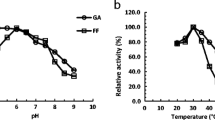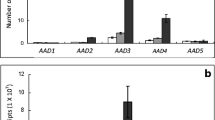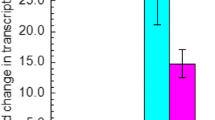Abstract
Scheffersomyces (Pichia) stipitis is one of the most promising yeasts for industrial bioethanol production from lignocellulosic biomass. S. stipitis is able to in situ detoxify aldehyde inhibitors (such as furfural and 5-hydroxymethylfurfural (HMF)) to less toxic corresponding alcohols. However, the reduction enzymes involved in this reaction remain largely unknown. In this study, we reported that an uncharacterized open reading frame PICST_72153 (putative GRE2) from S. stipitis was highly induced in response to furfural and HMF stresses. Overexpression of this gene in Saccharomyces cerevisiae improved yeast tolerance to furfural and HMF. GRE2 was identified as an aldehyde reductase which can reduce furfural to FM with either NADH or NADPH as the co-factor and reduce HMF to FDM with NADPH as the co-factor. This enzyme can also reduce multiple aldehydes to their corresponding alcohols. Amino acid sequence analysis indicated that it is a member of the subclass “intermediate” of the short-chain dehydrogenase/reductase (SDR) superfamily. Although GRE2 from S. stipitis is similar to GRE2 from S. cerevisiae in a three-dimensional structure, some differences were predicted. GRE2 from S. stipitis forms loops at D133-E137 and T143-N145 locations with two α-helices at E154-K157 and E252-A254 locations, different GRE2 from S. cerevisiae with an α-helix at D133-E137 and a β-sheet at T143-N145 locations, and two loops at E154-K157 and E252-A254 locations. This research provided guidelines for the study of other SDR enzymes from S. stipitis and other yeasts on tolerant mechanisms to aldehyde inhibitors derived from lignocellulosic biomass.







Similar content being viewed by others
References
Agbogbo FK, Coward-Kelly G (2008) Cellulosic ethanol production using the naturally occurring xylose-fermenting yeast, Pichia stipitis. Biotechnol Lett 30:1515–1524. doi:10.1007/s10529-008-9728-z
Allen SA, Clark W, McCaffery JM, Cai Z, Lanctot A, Slininger PJ, Liu ZL, Gorsich SW (2010) Furfural induces reactive oxygen species accumulation and cellular damage in Saccharomyces cerevisiae. Biotechnol Biofuels 3:2. doi:10.1186/1754-6834-3-2
Antal MJ, Leesomboon T, Mok WS, Richards GN (1991) Mechanism of formation of 2-furaldehyde from D-xylose. Carbohyd Res 217:71–85. doi:10.1016/0008-6215(91)84118-X
Bowman MJ, Jordan DB, Vermillion KE, Braker JD, Moon J, Liu ZL (2010) Stereochemistry of furfural reduction by a Saccharomyces cerevisiae aldehyde reductase that contributes to in situ furfural detoxification. Appl Environ Microbiol 76:4926–4932. doi:10.1128/AEM.00542-10
Chen CN, Porubleva L, Shearer G, Svrakic M, Holden LG, Dover JL, Johnston M, Chitnis PR, Kohl DH (2003) Associating protein activities with their genes: rapid identification of a gene encoding a methylglyoxal reductase in the yeast Saccharomyces cerevisiae. Yeast 20:545–554. doi:10.1002/yea.979
Delgenes JP, Moletta R, Navarro JM (1996) Effects of lignocellulose degradation products on ethanol fermentations of glucose and xylose by Saccharomyces cerevisiae, Zymomonas mobilis, Pichia stipitis, and Candida shehatae. Enzym Microb Technol 19:220–225. doi:10.1016/0141-0229(95)00237-5
Ding MZ, Wang X, Liu W, Cheng JS, Yang Y, Yuan YJ (2012) Proteomic research reveals the stress response and detoxification of yeast to combined inhibitors. PLoS One 7:e43474. doi:10.1371/journal.pone.0043474
du Preez JC, Prior BA (1985) A quantitative screening of some xylose fermenting yeast isolates. Biotechnol Lett 7:241–248. doi:10.1007/BF01042370
Garay-Arroyo A, Covarrubias AA (1999) Three genes whose expression is induced by stress in Saccharomyces cerevisiae. Yeast 15:879–892. doi:10.1002/(SICI)1097-0061(199907)15:10A<879::AID-YEA428>3.0.CO;2-Q
Gietz RD, Schiestl RH, Willems AR, Woods RA (1995) Studies on the transformation of intact yeast cells by the LiAc/SS-DNA/PEG procedure. Yeast 11:355–360. doi:10.1002/yea.320110408
Goldberg AL (2003) Protein degradation and protection against misfolded or damaged proteins. Nature 426:895–899. doi:10.1038/nature02263
Guo PC, Bao ZZ, Ma XX, Xia Q, Li WF (2014) Structural insights into the cofactor-assisted substrate recognition of yeast methylglyoxal/isovaleraldehyde reductase Gre2. Biochim Biophys Acta 1844:1486–1492. doi:10.1016/j.bbapap.2014.05.008
Hao XC, Yang XS, Wan P, Tian S (2013) Comparative proteomic analysis of a new adaptive Pichia stipitis strain to furfural, a lignocellulosic inhibitory compound. Biotechnol Biofuels 6:34. doi:10.1186/1754-6834-6-34
Hauser M, Horn P, Tournu H, Hauser NC, Hoheisel JD, Brown AJ, Dickinson JR (2007) A transcriptome analysis of isoamyl alcohol-induced filamentation in yeast reveals a novel role for Gre2p as isovaleraldehyde reductase. FEMS Yeast Res 7:84–92. doi:10.1111/j.1567-1364.2006.00151.x
Hazelwood LA, Daran JM, van Maris AJ, Pronk JT, Dickinson JR (2008) The Ehrlich pathway for fusel alcohol production: a century of research on Saccharomyces cerevisiae metabolism. Appl Environ Microbiol 74:2259–2266. doi:10.1128/AEM.02625-07
Heer D, Sauer U (2008) Identification of furfural as a key toxin in lignocellulosic hydrolysates and evolution of a tolerant yeast strain. Microb Biotechnol 1:497–506. doi:10.1111/j.1751-7915.2008.00050.x
Heer D, Heine D, Sauer U (2009) Resistance of Saccharomyces cerevisiae to high concentrations of furfural is based on NADPH-dependent reduction by at least two oxireductases. Appl Environ Microbiol 75:7631–7638. doi:10.1128/AEM.01649-09
Jayakody LN, Horie K, Hayashi N, Kitagaki H (2013) Engineering redox cofactor utilization for detoxification of glycolaldehyde, a key inhibitor of bioethanol production, in yeast Saccharomyces cerevisiae. Appl Microbiol Biotechnol 97:6589–6600. doi:10.1007/s00253-013-4997-4
Jeffries TW, Grigoriev IV, Grimwood J, Laplaza JM, Aerts A, Salamov A, Schmutz J, Lindquist E, Dehal P, Shapiro H, Jin YS, Passoth V, Richardson PM (2007) Genome sequence of the lignocellulose-bioconverting and xylose-fermenting yeast Pichia stipitis. Nat Biotechnol 25:319–326. doi:10.1038/nbt1290
Jönsson LJ, Alriksson B, Nilvebrant NO (2013) Bioconversion of lignocellulose: inhibitors and detoxification. Biotechnol Biofuels 6:16. doi:10.1186/1754-6834-6-16
Jordan DB, Braker JD, Bowman MJ, Vermillion KE, Moon J, Liu ZL (2011) Kinetic mechanism of an aldehyde reductase of Saccharomyces cerevisiae that relieves toxicity of furfural and 5-hydroxymethylfurfural. Biochim Biophys Acta 1814:1686–1694. doi:10.1016/j.bbapap.2011.08.011
Kavanagh KL, Jörnvall H, Persson B, Oppermann U (2008) The SDR superfamily: functional and structural diversity within a family of metabolic and regulatory enzymes. Cell Mol Life Sci 65:3895–3906. doi:10.1007/s00018-008-8588-y
Kim SR, Park YC, Jin YS, Seo JH (2013) Strain engineering of Saccharomyces cerevisiae for enhanced xylose metabolism. Biotechnol Adv 31:851–861. doi:10.1016/j.biotechadv.2013.03.004
Klinke HB, Thomsen AB, Ahring BK (2004) Inhibition of ethanol-producing yeast and bacteria by degradation products produced during pre-treatment of biomass. Appl Microbiol Biotechnol 66:10–16. doi:10.1007/s00253-004-1642-2
Kumar R, Singh S, Singh OV (2008) Bioconversion of lignocellulosic biomass: biochemical and molecular perspectives. J Ind Microbiol Biotechnol 35:377–391. doi:10.1007/s10295-008-0327-8
Larsson S, Palmqvist E, Hahn-Hägerdal B, Tengborg C, Stenberg K, Zacchi G, Nilvebrant NO (1999) The generation of inhibitors during dilute acid hydrolysis of softwood. Enzym Microb Technol 24:151–159. doi:10.1016/S0141-0229(98)00101-X
Lewkowski J (2001) Synthesis, chemistry and applications of 5-hydroxymethylfurfural and its derivatives. ARKIVOC 1:17–54. doi:10.1002/chin.200302269
Liu ZL (2011) Molecular mechanisms of yeast tolerance and in situ detoxification of lignocellulose hydrolysates. Appl Microbiol Biotechnol 90:809–825. doi:10.1007/s00253-011-3167-9
Liu ZL, Blaschek HP (2010) Biomass conversion inhibitors and in situ detoxification. In: Vertès AA, Qureshi N, Blaschek HP, Yukawa H (eds) Biomass to biofuels: strategies for global industries. Wiley, Chichester, pp. 233–259
Liu ZL, Moon J (2009) A novel NADPH-dependent aldehyde reductase gene from Saccharomyces cerevisiae NRRL Y-12632 involved in the detoxification of aldehyde inhibitors derived from lignocellulosic biomass conversion. Gene 446:1–10. doi:10.1016/j.gene.2009.06.018
Liu ZL, Slininger PJ (2007) Universal external RNA controls for microbial gene expression analysis using microarray and qRT-PCR. J Microbiol Methods 68:486–496. doi:10.1016/j.mimet.2006.10.014
Liu ZL, Slininger PJ, Dien BS, Berhow MA, Kurtzman CP, Gorsich SW (2004) Adaptive response of yeasts to furfural and 5-hydroxymethylfurfural and new chemical evidence for HMF conversion to 2,5-bis-hydroxymethylfuran. J Ind Microbiol Biotechnol 31:345–352. doi:10.1007/s10295-004-0148-3
Liu ZL, Slininger PJ, Gorsich SW (2005) Enhanced biotransformation of furfural and 5-hydroxy methylfurfural by newly developed ethanologenic yeast strains. Appl Biochem Biotechnol 121–124:451–460. doi:10.1385/ABAB:121:1-3:0451
Liu ZL, Moon J, Andersh BJ, Slininger PJ, Weber S (2008) Multiple gene-mediated NAD(P)H-dependent aldehyde reduction is a mechanism of in situ detoxification of furfural and 5-hydroxymethylfurfural by Saccharomyces cerevisiae. Appl Microbiol Biotechnol 81:743–753. doi:10.1007/s00253-008-1702-0
Liu ZL, Ma M, Song M (2009a) Evolutionarily engineered ethanologenic yeast detoxifies lignocellulosic biomass conversion inhibitors by reprogrammed pathways. Mol Gen Genomics 282:233–244. doi:10.1007/s00438-009-0461-7
Liu ZL, Palmquist DE, Ma M, Liu J, Alexander NJ (2009b) Application of a master equation for quantitative mRNA analysis using qRT-PCR. J Biotechnol 143:10–16. doi:10.1016/j.jbiotec.2009.06.006
López-Rituerto E, Avenoza A, Busto JH, Peregrina JM (2010) Evidence of metabolic transformations of amino acids into higher alcohols through 13C NMR studies of wine alcoholic fermentation. J Agric Food Chem 58:4923–4927. doi:10.1021/jf904442d
Luo CD, Brink DL, Blanch HW (2002) Identification of potential fermentation inhibitors in conversion of hybrid poplar hydrolyzate to ethanol. Biomass Bioenerg 22:125–138. doi:10.1016/S0961-9534(01)00061-7
Ma M, Liu ZL (2010) Comparative transcriptome profiling analyses during the lag phase uncover YAP1, PDR1, PDR3, RPN4, and HSF1 as key regulatory genes in genomic adaptation to lignocellulose derived inhibitor HMF for Saccharomyces cerevisiae. BMC Genomics 11:660. doi:10.1186/1471-2164-11-660
Ma M, Wang X, Zhang X, Zhao X (2013) Alcohol dehydrogenases from Scheffersomyces stipitis involved in the detoxification of aldehyde inhibitors derived from lignocellulosic biomass conversion. Appl Microbiol Biotechnol 97:8411–8425. doi:10.1007/s00253-013-5110-8
Moon J, Liu ZL (2012) Engineered NADH-dependent GRE2 from Saccharomyces cerevisiae by directed enzyme evolution enhances HMF reduction using additional cofactor NADPH. Enzym Microb Technol 50:115–120. doi:10.1016/j.enzmictec.2011.10.007
Moon J, Liu ZL (2015) Direct enzyme assay evidence confirms aldehyde reductase function of Ydr541cp and Ygl039wp from Saccharomyces cerevisiae. Yeast 32:399–407. doi:10.1002/yea.3067
Naik SN, Goud VV, Rout PK, Dalai AK (2010) Production of first and second generation biofuels: a comprehensive review. Renew Sust Energ Rev 14:578–597. doi:10.1016/j.rser.2009.10.003
Nielsen J, Larsson C, van Maris A, Pronk J (2013) Metabolic engineering of yeast for production of fuels and chemicals. Curr Opin Biotechnol 24:398–404. doi:10.1016/j.copbio.2013.03.023
Outlaw J, Collins KJ, Duffield JA (2005) Agriculture as a producer and consumer of energy. CABI Publishing, Oxford
Parekh S, Wayman M (1986) Fermentation of cellobiose and wood sugars to ethanol by Candida shehatae and Pichia stipitis. Biotechnol Lett 8:597–600. doi:10.1007/BF01028092
Taherzadeh MJ, Eklund R, Gustafsson L, Niklasson C, Lidén G (1997) Characterization and fermentation of dilute-acid hydrolyzates from wood. Ind Eng Chem Res 36:4659–4665. doi:10.1021/ie9700831
Tamura K, Stecher G, Peterson D, Filipski A, Kumar S (2013) MEGA6: molecular evolutionary genetics analysis version 6.0. Mol Biol Evol 30:2725–2729. doi:10.1093/molbev/mst197
Thornalley PJ (1996) Pharmacology of methylglyoxal: formation, modification of proteins and nucleic acids, and enzymatic detoxification—a role in pathogenesis and antiproliferative chemotherapy. Gen Pharmacol 27:565–573. doi:10.1016/0306-3623(95)02054-3
Wang X, Xu H, Ha SW, Ju D, Xie Y (2010) Proteasomal degradation of Rpn4 in Saccharomyces cerevisiae is critical for cell viability under stressed conditions. Genetics 184:335–342. doi:10.1534/genetics.109.112227
Warringer J, Blomberg A (2006) Involvement of yeast YOL151W/GRE2 in ergosterol metabolism. Yeast 23:389–398. doi:10.1002/yea.1363
Acknowledgments
This work was supported by the National Natural Science Foundation of China (No. 31570086) and the Talent Introduction Fund of Sichuan Agricultural University (No. 01426100).
Author information
Authors and Affiliations
Corresponding authors
Ethics declarations
Human and animal rights
This article does not contain any studies with human participants or animals performed by any of the authors.
Competing interests
The authors declare that they have no competing interests.
Electronic Supplementary Material
ESM 1
(PDF 28 kb)
Rights and permissions
About this article
Cite this article
Wang, X., Ma, M., Liu, Z.L. et al. GRE2 from Scheffersomyces stipitis as an aldehyde reductase contributes tolerance to aldehyde inhibitors derived from lignocellulosic biomass. Appl Microbiol Biotechnol 100, 6671–6682 (2016). https://doi.org/10.1007/s00253-016-7445-4
Received:
Revised:
Accepted:
Published:
Issue Date:
DOI: https://doi.org/10.1007/s00253-016-7445-4




